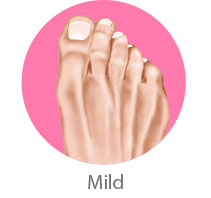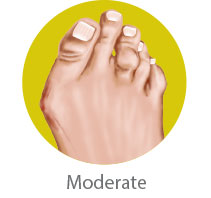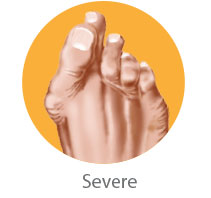
If you have a swollen, painful big toe, you may have developed a bunion. A bunion looks like a bony bump on the inside of the foot at the big toe joint. In reality, the bump forms when pressure on the big toe joint causes the big toe to lean toward the second toe, forcing the joint of the big toe to get bigger and stick out. A bunion (or hallux valgus) is a progressive disorder in which the deformity gradually increases, and the big toe joint may become stiff, painful, and swollen.
How did I get a bunion?
Most bunions are caused by inheriting a certain foot type that makes a person prone to developing a bunion. While wearing tight shoes or high heels does not necessarily cause bunions, those shoes can cause pain and swelling in the big toe joint and accelerate the bunion deformity. This is why more than one-third of American women get a bunion during their lifetime.

How do I make my bunion go away?
Unfortunately, bunions are a progressive deformity that doesn’t go away and may get worse over time. To minimize the progression of a bunion, doctors recommend avoiding shoes that are too short, too tight or sharply pointed and those with heels higher than 2 ¼ inches. Learn what you can do about your bunion below.
What are the non-surgical treatment options for a bunion?
Non-surgical treatment options are aimed at easing pain and slowing down the progression of the bunion. Your doctor may recommend changes in footwear, padding, orthotics, icing, and/or pain relievers to minimize the discomfort you experience and to prevent the bunion from becoming more severe. If conservative treatment doesn’t ease your pain, your doctor may recommend surgery. Click here to find a foot doctor near you.
What are the surgical treatment options for a bunion?
The goal of bunion surgery is to alleviate your bunion pain. During the surgery the surgeon will realign the bone, ligaments, tendons, and nerves so your big toe can be brought back to its correct position. Usually, bunion surgery can be done as an outpatient procedure in a surgery center rather than a hospital and without a hospital stay. Patients are usually able to have surgery and go home within a few hours after surgery. Bunion surgery is typically covered by most insurance company policies.
Since bunions come in different sizes and shapes, surgical treatment options will depend on the extent of your bunion – mild, moderate or severe, along with your age, x-ray findings, physical exam, and activity level. The surgeon will select the bunion procedure that is best suited for your bunion. The amount of time needed to recover from bunion surgery can vary greatly and a lot depends on the surgical procedure or procedures selected by your surgeon.
Surgical Treatment for Mild to Moderate Bunions
miniBunion® Technique
For mild or moderate bunions, the miniBunion system uses a minimally-invasive surgery technique for implanting a micro-titanium implant. Unlike traditional procedures, the miniBunion technique requires a small incision 2 to 4-times smaller than a standard technique and involves much less trauma to the soft-tissues surrounding the toes. This technique spares the blood supply to the bones and allows less pain, a smaller scar and faster recovery than open bunion surgeries.
Patients are given a postoperative shoe, and typically can walk immediately following surgery, dependent on the surgeon’s recommendation.

Surgical Treatment for Mild to Moderate Bunions
Distal Chevron Osteotomy
This common surgery is utilized for mild to moderate bunions and involves straightening the big toe bone and adjusting soft tissue around the joint. The long bone leading to the toe is cut to realign the bone structure in the foot. Surgical plates or screws can sometimes be used to reattach the tip of the bone to the long bone to keep the new alignment.
While the Chevron Osteotomy is also an outpatient surgery, the recovery time is generally much longer compared to minimally invasive techniques. Patients are given a boot to wear during recovery and will be required to keep weight off their feet six to eight weeks.

Surgical Treatment for Mild to Moderate Bunions
Open Bunion Surgery
Open bunion surgery requires one or multiple incisions ranging from 2-6 inches in length. During surgery, the surgeon will cut and dissect quite a bit of soft tissue before cutting the bone for realignment. After securing screws and/or plates onto the bone, the surgeon stitches up the soft tissue and skin incision. Due to the extensive soft tissue dissection, the recovery requires six to eight weeks of rehabilitation. A complete recovery can take four to six months.

Surgical Treatment for Mild to Moderate Bunions
Lapidus Procedure with Staple Compression Plates™
The Lapidus procedure may be selected in a mild bunion if there is increased mobility or movement through the joint of the middle of the foot. When the joint in the middle of the foot is too loose or has too much movement, the condition is called hypermobility or instability. This instability causes the big toe to compensate by moving toward the second toe and a bunion to form. In a Lapidus procedure, this unstable joint is fused to help eliminate the movement in the joint and eliminate the need for the big toe to compensate by moving toward the second toe and forming a bunion.
With a Lapidus procedure, an incision is made on the top of the foot. The surgeon will remove the cartilage from two bones of the midfoot and realign the bones. Once the bones are aligned, the surgeon attaches plates and screws to hold the bones in place to grow together and fuse the joint to eliminate the instability.
With the Lapidus Staple Compression Plate™, patients will get continuous compression with the staple which is required for the bones to fuse and stability from the plate that holds the bones in the correct alignment until the bones are healed. If there is too much motion between the bones, it can take longer for the bones to heal. Staple Compression Plates™ are the only plates available that provide stability and continuous compression until the bones are healed. For the first time, patients will get both continuous compression and stability to provide an ideal healing environment.
Recovery from a Lapidus procedure is a little longer than other surgical options due to the time needed for the bones to fuse together. Typically, it takes 6-8 weeks for the bones to heal. However, with the continuous compression and plate stability of the Staple Compression Plates™, patients may be allowed to walk much sooner in a splint or boot.

Moderate or Severe Bunions
dynaBunion® Procedure
The dynaBunion® procedure may be selected for a bunion if there is increased mobility or movement through the joint of the middle of the foot. When the joint in the middle of the foot is too loose or has too much movement, the condition is called hypermobility or instability. This instability causes the big toe to compensate by moving toward the second toe and a bunion forms.
In a dynaBunion® procedure, the bones are aligned in all four dimensions and the unstable joint is fused through a minimal-incision. Unlike traditional open bunion surgeries, this 4D procedure corrects the bunion in all four dimensions through a minimal-incision which can offer a walking recovery, less tissue damage, a smaller scar…and a return to stylish shoes.

Surgical Treatment for Severe Bunions
Lapidus Procedure with Staple Compression Plates™
The Lapidus procedure may be selected in a severe bunion if there is a very large angle or increased mobility or movement through the joint of the middle of the foot. When the joint in the middle of the foot is too loose or has too much movement, the condition is called hypermobility or instability. This instability causes the big toe to compensate by moving toward the second toe and a bunion to form. In a Lapidus procedure, this unstable joint is fused to help eliminate the movement in the joint and eliminate the need for the big toe to compensate by moving toward the second toe and forming a bunion.
With a Lapidus procedure, a big incision is made on the top of the foot. The surgeon will remove the cartilage from both bone surfaces and realign the two bones of the midfoot. Once the bones are aligned, the surgeons attaches plates and screws to hold the two bones in place to grow together and fuse the joint to eliminate the instability.
With the Lapidus Staple Compression Plate™, patients will get continuous compression with the staple which is required for the bones to fuse and stability from the plate that holds the bones in the correct alignment until the bones are healed. If there is too much motion between the bones, it can take longer for the bones to heal. Staple Compression Plates™ are the only plates available that provide stability and continuous compression until the bones are healed. For the first time, patients will get both continuous compression and stability to provide an ideal healing environment.
Recovery from a lapidus procedure is a little longer than other surgical options due to the time needed for the bones to fuse together. Typically, it takes 6-8 weeks for the bones to heal. However, with the continuous compression and plate stability of the Staple Compression Plates™, patients may be allowed to walk much sooner in a splint or boot.

Surgical Treatment for Severe Bunions
Open Bunion Surgery
Open bunion surgery requires one or multiple incisions ranging from 2-6 inches in length. During surgery, the surgeon will cut and dissect quite a bit of soft tissue before cutting the bone for realignment. After securing screws and/or plates onto the bone, the surgeon stitches up the soft tissue and skin incision.
Due to the extensive soft tissue dissection, the recovery requires six to eight weeks of rehabilitation. A complete recovery can take four to six months.




